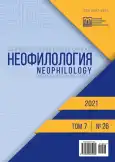Periphrases as a form of thinking
- Authors: Du C.1
-
Affiliations:
- Zhejiang Yuexiu University of Foreign Languages
- Issue: Vol 7, No 26 (2021)
- Pages: 213-219
- Section: РУССКИЙ ЯЗЫК
- URL: https://journals.rcsi.science/2587-6953/article/view/302443
- DOI: https://doi.org/10.20310/2587-6953-2021-7-26-213-219
- ID: 302443
Cite item
Full Text
Abstract
We attempt to consider the reproduction of the meaning of the word HOME in the periphrastic constructions used in the Russian translations of the poem by the Chinese poet Li Bai. Based on analysis of six translations of the poem “Quiet Night Thought” we prove that periphrastic unit is not only used instead of the name of the object, but with the name of the object. We establish that in the translations of the poem by the Chinese author, the periphrastic names representing the concept of HOME reflect the form of thinking due to the semantics read at the nonverbal level. The periphrastic unit HOME is an analogue of the microcosm and macrocosm, transmitting neutral interpretations, which allows the periphrase to convey a relatively complete descriptive meaning, since by its semantics it strives to form a single semantic concept of the concept of “home”. We substantiate that cultural information is not included in the semantic minimum of the sign and may be irrelevant in practice, but the periphrase, as a secondary sign, always has connotations that are especially important in the reflective flow of speech, when the factor of understanding a written translated text is not only decoding of the written text, but also the interpretation of the communicative settings of information of the original text creator.
Keywords
About the authors
Chunyang Du
Zhejiang Yuexiu University of Foreign Languages
Author for correspondence.
Email: duchunyang92@bk.ru
ORCID iD: 0000-0001-8511-475X
Lecturer of Russian Language Department
428 Kuaiji St., Shaoxing 312000, People’s Republic of ChinaReferences
- Karaulova Y.N. (ed.). Russkiy yazyk. Entsiklopediya [Russian Language. Encyclopedia]. Moscow, Great Russian Encyclopedia Publ., Drofa Publ., 2008, 705 p. (In Russian).
- Akhmanova O.S. Slovar’ lingvisticheskikh terminov [Dictionary of Linguistic Terms]. Moscow, KomKniga Publ., 2007, 608 p. (In Russian).
- Norlusenyan V.S. Perifrazy v sovremennom publitsisticheskom tekste: pragmalingvistichskiy aspect [Periphrasis in modern publicistic text: multilevel aspect]. Baltiyskiy gumanitarnyy zhurnal – Baltic Humanitarian Journal, 2017, vol. 6. no. 4 (21), pp. 137-139. (In Russian).
- Shcherbak A.S. Onomasticheskoye soznaniye kak kognitivno-yazykovaya sistema [Onomastic consciousness as a cognitive-linguistic system]. Kognitivnyye issledovaniya yazyka [Cognitive Studies of Language]. Moscow, Institute of linguistics RAS; Tambov, Publishing House of Derzhavin Tambov State University, 2020, pp. 301-304. (In Russian).
- Lukina K.E. Substantivy, ob”yektiviruyushchiye kontsept SUBSTANCE, i modeli ikh sozdaniya [Substances that objectify the SUBSTANCE concept and models for their creation]. Neofilologiya – Neophilology, 2020, vol. 6, no. 21, pp. 67-75. (In Russian). doi: 10.20310/2587-6953-2020-6-21-67-75
- Moskvin V.P. O raznovidnostyakh perifrazy [About the varieties of periphrase]. Russkiy yazyk v shkole – Rus-sian Language at School, 2001, no. 1, pp. 74-77. (In Russian).
- Wierzbika A. Słowa klucze. RóŜne języki róŝne kultury. Warszawa, Wydawnictw Uniwersytetu Warszawskiego, 2007, 563 p. (In Polish).
- Babenko L.G. Slovar’ sinonimov russkogo yazyka [The Dictionary of Synonyms of the Russian Language]. Moscow, Astrel, AST Publ., 2011, 688 p. (In Russian).
- Sinina A.I. Kognitivno-semanticheskaya i funktsional’no-pragmaticheskaya spetsifika perifrazy v sovremennoy angloyazychnoy publitsistike: avtoref. dis. ... kand. filol. nauk [Cognitive-Semantic and Functional-Pragmatic Specificity of Periphrasis in Modern English-Language Journalism. Cand. philol. sci. diss. abstr.]. Volgograd, 2012, 20 p. (In Russian).
- Du Chunyan. Sootnosheniye perifrasticheskogo naimenovaniya nebesnykh tel i sinonima [Celestial objects periphrastic naming and synonym correlation]. Neofilologiya – Neophilology, 2020, vol. 6, no. 21, pp. 34-40. (In Russian). doi: 10.20310/2587-6953-2020-6-21-34-40
Supplementary files










